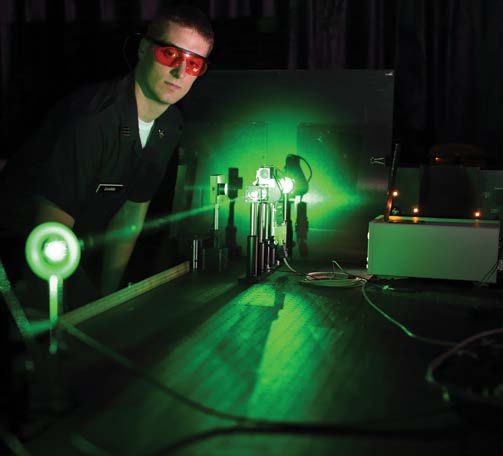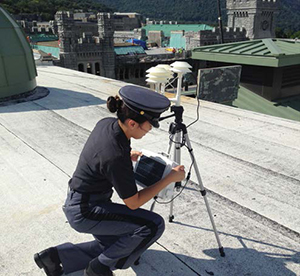PHOTONICS RESEARCH CENTER
Interdisciplinary Approach to Today's Battlespace
 The Photonics Research Center (PRC) is West Point’s home to photonics and optics experts, faculty, and researchers from diverse fields of study. An original creation of the Department of Physics & Nuclear Engineering (PANE), the PRC serves as a conduit for research into laser and photonics applications. The center supports the Army and other Department of Defense (DoD) agencies through collaboration with the USMA Departments of Chemistry & Life Science, Electrical Engineering & Computer Science, as well as the Army Research Office and the Army Research Laboratory.
The Photonics Research Center (PRC) is West Point’s home to photonics and optics experts, faculty, and researchers from diverse fields of study. An original creation of the Department of Physics & Nuclear Engineering (PANE), the PRC serves as a conduit for research into laser and photonics applications. The center supports the Army and other Department of Defense (DoD) agencies through collaboration with the USMA Departments of Chemistry & Life Science, Electrical Engineering & Computer Science, as well as the Army Research Office and the Army Research Laboratory.
Cadets and faculty conduct cutting-edge research into producing and harnessing the power of ultraviolet, visible, and infrared light-using lasers, imaging, fiber optics, night vision, remote sensing, and more.
One research area in which the PRC is heavily involved is directed energy weapon systems in the form of lasers capable of producing both reversible and non-reversible battlefield effects. The PRC is tasked with understanding these effects to further DoD high-energy laser projects in real-world use. The High Energy Laser (HEL) project began in 2006 as an effort to examine the military utility of using lasers to defend against rockets, mortars, and artillery. The team started with an interdisciplinary approach to compare the state-of-the-art at the time and has evolved into testing and modeling laser-material interactions of metals and other materials. Recently, the project has focused on the construction of a mobile laser system that can be deployed to outdoor range facilities, where cadets and faculty researchers in the PRC will be able to measure the atmospheric effects on beam propagation and resulting target damage.
Since it began, over 15 faculty members and 70 cadets have worked on the HEL project. PRC researchers frequently publish in top journals and present research at conferences hosted by the Directed Energy Professional Society (DEPS), the Institute of Electrical and Electronics Engineers (IEEE), the Society of Photographic Instrumentation Engineers (SPIE), and the Optical Society of America (OSA), among others. This work is contributing to solving Army problems on game-changing emerging technologies, as well as a contributor to cadet leader development through experiential and hands-on learning. Through PRC research, cadets must solve difficult, multi-faceted problems that don’t have a known solution. In this way, cadets are exposed to dilemmas that leaders often face—each with positive and negative options and respective consequences that follow—and requires them to fall back on their education as well as leverage each other’s skills to arrive at a solution that meets the provided requirements. As soldiers gain access to more technology on the battlefield, it is important to increase their capabilities rather than provide more devices. The enhancement of the PRC will meaningfully expand and modernize cadet curriculum, adaptability, and help to create stronger, more nimble leaders.
 Thanks to an anonymous donor, the first to support this new initiative, the Photonics Research Center Endowment has been established to support high-energy laser and photonics research in the PRC. The endowment will enable cadets and faculty to establish an Outdoor–High Energy Laser Lab (O-HELL) in the West Point range complex and conduct important research. “The O-HELL will be used to test the propagation of high-energy lasers through the atmosphere near the surface of the Earth as well as laser-material interactions. The results of the research will be used by the Army and the Department of Defense in the development of directed energy systems. The research not only develops technical solutions to Army problems but more importantly develops a group of officers in the form of USMA graduates and returning field grade officers with knowledge of laser technologies and capabilities for the defense of the nation,” said COL John Hartke, Professor of Photonics Head of the Department of Physics and Nuclear Engineering.
Thanks to an anonymous donor, the first to support this new initiative, the Photonics Research Center Endowment has been established to support high-energy laser and photonics research in the PRC. The endowment will enable cadets and faculty to establish an Outdoor–High Energy Laser Lab (O-HELL) in the West Point range complex and conduct important research. “The O-HELL will be used to test the propagation of high-energy lasers through the atmosphere near the surface of the Earth as well as laser-material interactions. The results of the research will be used by the Army and the Department of Defense in the development of directed energy systems. The research not only develops technical solutions to Army problems but more importantly develops a group of officers in the form of USMA graduates and returning field grade officers with knowledge of laser technologies and capabilities for the defense of the nation,” said COL John Hartke, Professor of Photonics Head of the Department of Physics and Nuclear Engineering.
WPAOG is seeking to expand the endowment in order to further the work of the PRC to help the Army meet the threats of today’s battlespace. With the enhancement and addition of new photonics and testing equipment, much-needed new spatial configurations, and a dedicated post-doctoral photonics researcher, the PRC will become a driving force that ensures photonics research efforts on vital Army and DoD projects continuously and consistently move forward.